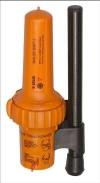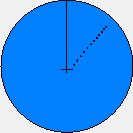Search and Rescue Radar Transponder
|
 |
A Search and Rescue Transponder (SART) is an electronic device that automatically reacts to the emission of a radar. This enhances the visibilty on a radar screen. SART transponders are used to ease the search of a ship in distress or a liferaft. All GMDSS vessels up to 500 ton must carry at least one SART. Bigger vessels must carry at least two SARTs. Non GMDSS vessels are strongly advised to carry at least one as well. |
A SART has a receiver that detects the signals from X-band radars (9.2 - 9.5 GHz). If the SART detects a signal it immediately transmits twelve pulses on the same frequency. This signal is seen by the radar as "echoes" and will be displayed on the screen as a serie of twelve dots with a gap of 0.6 miles between them. The first dot is at the position of the SART and the others go in a straight line towards the edge of the screen.
 |
If the rescue vessel approaches the SART, the twelve dots will become short arcs. These arcs increase in size if the vessel gets closer. If the rescue vessel is very close, the SART will be activated permanentely by the side lobes of the radar antenna. The signal of the SART will then be visible as twelve complete circles on the radar screen. This will tell the search-and-rescue team that they have more or less arrived.